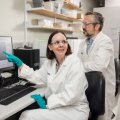The University of Queensland and M.I.M. Holdings Limited have announced a major initiative to overcome an Australian shortage of mineral process engineers.
University Vice-Chancellor Professor John Hay and MIM chief executive Nick Stump announced that MIM would financially assist the University to establish a new chair in minerals engineering.
To be known as the MIM chair in minerals engineering, the professorship will complement the University's existing chairs in mining geology, mining engineering and materials engineering.
Professor Hay said minerals engineering was the essential link between mining engineering, which produced the ore, and materials engineering, which resulted in finished metal products.
He said there was currently no chair in minerals engineering in the Department of Mining, Minerals and Materials Engineering. This limited the University's capacity in teaching and research in minerals engineering, and to produce the numbers of students in this discipline that were clearly required by the expanding minerals industry.
'A chair in minerals engineering will unlock new opportunities, and will enhance the teaching and research relationships between the Department and its principal industry research interface, the Julius Kruttschnitt Mineral Research Centre,' he said.
Mr Stump said that as one of Australia's leading mineral producers, MIM had a strong interest in progressing innovation in minerals production and advancing Australia's exports in this field.
'MIM and its operations, in particular those at Mount Isa, have been committed financial, practical and moral supporters of the University and its Mining and Metallurgical Engineering Department (as it was then known) since its inception in 1949,' Mr Stump said.
'In 1970 MIM provided funds to establish a flagship enterprise, the Julius Kruttschnitt Mineral Research Centre (JKMRC) within the Department.
'The company's continuing support has assisted the JKMRC to become an internationally recognised research and postgraduate training centre.'
More than 130 masters and PhD degrees have been awarded to the JKMRC's students and its best-selling mining and mineral processing software is marketed in more than 30 countries.
Mr Stump said MIM saw the decision to support a new chair as an important way to continue a relationship built on a mutual desire to improve the quality of undergraduate and postgraduate education and research.
Professor Hay congratulated MIM on its far-sighted initiative.
'No other single company in the Queensland mining community has had a such a long, close and productive relationship with the University in mining, minerals and materials education and research activity,' he said.
'The new chair will lift the profile of minerals engineering, and thus address the priority of attracting more undergraduates to this important discipline.'
MIM's chief executives since the era of then chairman Julius Kruttschnitt - Sir George Fisher, Sir James Foots, Sir Bruce Watson, Norm Fussell and now Mr Stump - had developed and enhanced the Mount Isa/University connection.
'The company has contributed to our training programs by providing scholarships, vacation employment, and lending key staff to share their expertise with our students,' he said.
Professor Hay said the University had arguably the best coverage of teaching and research for the mining and mineral industry within the Australian university system.
'The expertise within the Sir James Foots Institute of Mineral Resources includes the Departments of Mining, Minerals and Materials Engineering and Earth Sciences, and research Centres including the W.H. Bryan Mining Geology Unit, the Julius Kruttchnitt Mineral Research Centre and the Centre for Mined Land Rehabilitation,' he said.
Head of the Mining, Minerals and Materials Engineering Department Professor Barry Brady said establishment of the MIM chair in mineral processing was a landmark development in the University's mining and minerals program.
'It completes the sequence of chairs in mining geology, mining engineering and mineral processing. The chair will provide a focus for strengthening the mineral processing program in the department, and will give mineral processing the same national and international prominence that the University of Queensland's mining program currently enjoys,' Professor Brady said.
'MIM has been a strong supporter of the mining program for many years and this generous contribution will provide impetus for significant improvement in the mineral processing discipline.'
The new chair will build on the Department's existing research program in minerals process engineering concentrated in two principal areas, mineral and coal processing, and pyrometallurgy.
The Minerals and Coal Processing Group has close links with both the Centre for Mining Technology and Equipment (CMTE) and the Julius Kruttschnitt Mineral Research Centre.
The Pyrometallurgy Research Group undertakes basic, applied and contract research on the production, smelting and refining of metals. This group has co-operative research projects with the Centre for Research in Computational Thermochemistry, Montreal, Canada.
For further information, contact Mr Stump, telephone 07 3833 8176 or
.jpg)



